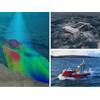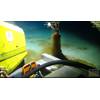NOAA Awards $41 Million for Ocean Observing

A joint deployment of an environmental sensor processor off the Washington coast by NOAA and the Northwest Association of Networked Ocean Observing Systems, one of the certified IOOS regional associations. (Photo: Stephanie Moore/NOAA)
The National Oceanic and Atmospheric Administration’s (NOAA) U.S. Integrated Ocean Observing System (IOOS) Office on Tuesday announced 11 new five-year cooperative agreements that support the continued growth, expansion, and modernization of our nation’s climate, coastal, ocean and Great Lakes observing capabilities. In the first year, NOAA will distribute $41 million to cover efforts along U.S. national and territorial waters and coasts.
"More than 40% of the U.S. population lives along the coast, and even more rely on the ocean, coast, and Great Lakes for their livelihoods, weather, and services every day," said Carl C. Gouldman, director, U.S. IOOS Office. "The IOOS Regional Associations link on-the-ground needs to our national system, ensuring its flexibility, responsiveness, and diversity while coordinating a network of regional coastal observing systems."
Federally certified to gather and manage high-quality observing data, the Regional Associations give diverse groups—including state, local and tribal governments, national partners, academia and local networks—a voice in shaping a responsive and flexible national observing system. This network is customized to meet regional needs that help us understand and forecast changes in our ocean and climate, prepare for and respond to coastal disasters and balance the needs of resource use, economic development and environmental stewardship.
The funds are awarded through a competitive process that includes funds from U.S. IOOS along with NOAA’s National Ocean Service, Office of Oceanic and Atmospheric Research, National Weather Service, NOAA Fisheries, Office of Marine and Aviation Operations; the U.S. Geological Survey; and the Environmental Protection Agency.
•Over the next five years, the Alaska Ocean Observing System will focus on maintaining and enhancing their Ocean Data Explorer while supporting initiatives that respond to Alaska region needs, such as the Alaska Ocean Observing Network. (First year award: $4,176,512)
•The Caribbean Coastal Ocean Observing System efforts are focused on maintaining and enhancing existing capabilities while filling information gaps identified through need assessments including the enhancement and expansion of observational and forecasting efforts that support incident response, maritime operations, ecosystems and fisheries, post-hurricane restoration and reconstruction. (First year award: $2,587,784)
•The Central and Northern California Ocean Observing System aims to integrate advancing observing technologies to fill critical gaps in biological and ecosystem observing and continue to collaborate with partners to provide high-priority biological and ecosystem-level information. (First year award: $4,054,052)
•The Gulf of Mexico Coastal Ocean Observing System will support: water quality monitoring for biological parameters, including harmful algal blooms; uncrewed glider operations to enhance hurricane modeling and forecasting to protect communities; and enhance high-frequency radar coverage. (First year award: $4,294,944)
•The Great Lakes Observing System is expanding their powerful, cloud-based platform to get lake information into the hands of more people than ever before as well as helping to organize the bi-national, cross-sector Smart Great Lakes Initiative to address pressing lake monitoring needs of today and to prepare for those of the next decade. (First year award: $3,074,314)
•Building on the robust history of strong partnerships in the region, the Mid-Atlantic Regional Association Coastal Ocean Observing System will continue to address coastal hazards, water quality, maritime commerce & safety, fisheries and natural resources, and energy including the rapidly changing offshore wind sector. (First year award: $4,984,041)
•Northwest Association of Networked Ocean Observing Systems will continue investment in observing and modeling in the coastal ocean, estuaries, and shorelines of Oregon and Washington, providing real-time information and integrated data products to support known and emerging stakeholder needs. (First year award: $3,932,271)
•The Northeastern Regional Association of Coastal Ocean Observing Systems will continue to sustain its data buoys, which are the heart of the NERACOOS network, while increasing investment in data delivery systems and modeling efforts. (First year award: $3,442,301)
•Guided by stakeholder needs, the Pacific Islands Ocean Observing System’s focus for the upcoming five years will be to sustain existing ocean observations and forecasts, support coastal resiliency and climate adaptation, and strive for a more balanced geographical coverage throughout the entire Pacific Islands region. (First year award: $3,085,080)
•The Southern California Coastal Ocean Observing System is focused on implementing ocean technology, observing, and interpreting data that provides integrated, user-driven information and data products that are valuable to our stakeholders including maritime transport at the Ports of Los Angeles and Long Beach and wastewater discharge in southern California. (First year award: $2,968,305)
•Over the next five years, the Southeast Coastal Ocean Observing Regional Association (SECOORA) will continue to support and maintain a broad network of observing infrastructure and data tools while addressing resiliency planning and emergency response, such as a water level observatory that will include 200 water level sensors across the four-state region. (First year award: $4,552,445)
















 February 2024
February 2024



